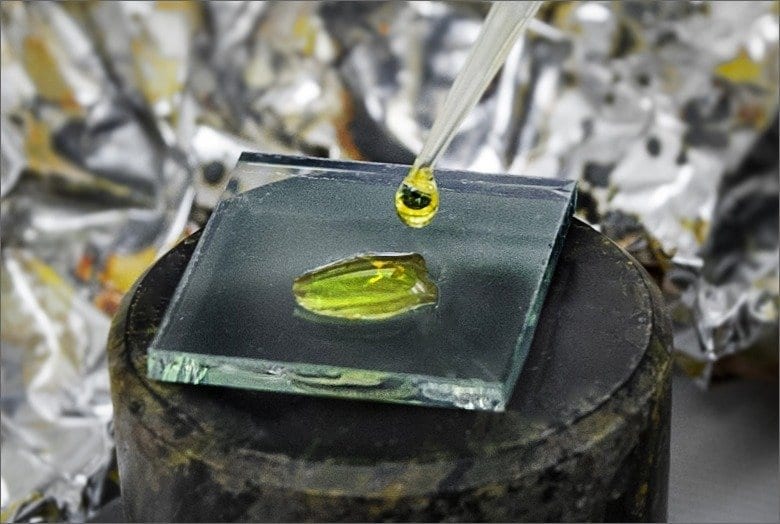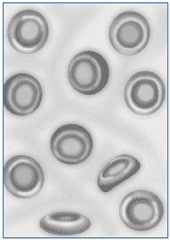
The majority of talks, posters, and papers proposed for the conference are on the subject of perovskite—so exciting is the field even though perovskite isn’t technically a dye cell
A new solar material that has the same crystal structure as a mineral first found in the Ural Mountains in 1839 is shooting up the efficiency charts faster than almost anything researchers have seen before—and it is generating optimism that a less expensive way of using sunlight to generate electricity may be in our planet’s future.
Researchers at the Energy Department’s National Renewable Energy Laboratory (NREL) are analyzing the new material, perovskite, using the lab’s unique testing capabilities and broad spectrum of expertise to uncover the secrets and potential of the semiconducting cube-like mineral.
NREL has already produced three scientific papers on perovskite (see sidebar), reporting on the science behind the very large length of the electron pairs (or charge diffusion length) in mesostructured perovskite solar cells. The two most-studied perovskite device structures are mesostructured (of medium complexity) and planar (two-dimensional). NREL Research Fellow David Ginley, who is a world-renowned materials scientist and winner of several R&D 100 Awards, said what makes perovskite device structures so remarkable is that when processed in a liquid solution, they have unusual abilities to diffuse photons a long distance through the cell. That makes it far less likely that the electrons will recombine with their hole pairs and be lost to useful electricity. And that indicates a potential for low-cost, high-efficiency devices.
NREL Senior Scientist Daniel Friedman notes that the light-absorbing perovskite cells have “a diffusion length 10 times longer than their absorption length,” not only an unusual phenomenon, but a very useful one, too.
Perovskite Is Flexible, Easier to Manipulate
The new cells are made from a relative of the perovskite mineral found in the Ural Mountains. Small but vital changes to the material allow it to absorb sunlight very efficiently. The material is also easy to fabricate using liquids that could be printed on substrates like ink in a printing press, or made from simple evaporation. These properties suggest an easy, affordable route to solar cells.
By playing with the elemental composition, it is also possible to tune the perovskite material to access different parts of the sun’s spectrum. That flexibility can be crucial, because it means that the material can be changed by deliberately introducing impurities, and in such a way that it can be used in multijunction solar cells that have ultra-high efficiencies. Multijunction solar cells are an NREL invention from 1991, but because of high material costs, standard multijunctions are used mostly in outer space applications such as satellites and the Mars rovers. Cheaper multijunction cells based on perovskites could radically change this.
In four years, perovskite’s conversion efficiency—the yield at which the photons that hit the material are turned into electrons that can be used to generate electricity—has grown from 3.8% in 2009 to just north of 16%, with unconfirmed reports of even higher efficiencies arriving regularly. That’s better than a four-fold increase. By contrast, efficiencies of single-crystal solar cells grew by less than 50% during their first five years of development, and most other types of solar cells showed similar modest improvements during their first few years.
NREL materials scientists are encouraged by the possibility of further optimizing the materials. For example, replacing lead with tin in the cells could improve the efficiency of multijunction cells made from perovskite. Besides switching to a more environmentally friendly material, the change from lead to tin would also allow the finished solar cell to better withstand high humidity.
Read more and search on “Perovskite” here for more info . . .
The Latest on: Perovskite
[google_news title=”” keyword=”Perovskite” num_posts=”10″ blurb_length=”0″ show_thumb=”left”]
via Google News
The Latest on: Perovskite
- NREL outlines way forward for tandem cellson May 1, 2024 at 7:15 am
The vast majority of solar modules in use today rely on a single junction, which is able to absorb only a fraction of the solar spectrum and thus are limited to how efficient they can be. Tandem solar ...
- Is perovskite PV still the future of solar?on May 1, 2024 at 3:01 am
So, is perovskite PV still the future of solar? It seems likely to have place among the solutions, at the very least. Applications will get more energy efficient. The need to efficient solar is ...
- Tin halide perovskite solar cell based on new precursor additive achieves 12.22% efficiencyon April 30, 2024 at 5:00 pm
A group of researchers led by the Chungbuk National University in South Korea has designed a tin halide perovskite (Sn-HP) solar cell that utilizes an additive known as 4-Phenylthiosemicarbazide ...
- Study finds CsPbBr₃ out-of-phase perovskite helps highly sensitive X-ray detectionon April 29, 2024 at 2:17 pm
A recent study conducted by the research team at Hefei Institutes of Physical Science of the Chinese Academy of Sciences, has introduced a new method for enhancing X-ray detection by incorporating out ...
- Fueling the future: Researchers evaluate emissions in the aviation industryon April 29, 2024 at 1:59 pm
A research group led Prof. Fei Wei and Chenxi Zhang in Tsinghua University has published a perspective paper that evaluates the progression from deep-rooted fossil-fuel-dependent technologies to ...
- A strategy to boost the efficiency of perovskite/organic photovoltaic cellson April 29, 2024 at 5:32 am
While perovskite/organic tandem solar cells could theoretically achieve high PCEs and stabilities, their performance is hindered by a process known as phase segregation. This process degrades the ...
- Towards novel promising perovskite-type ferroelectric materials: High-pressure synthesis of rubidium niobateon April 25, 2024 at 1:37 pm
Capacitors are crucial components in electronic devices such as smartphones and computers. They are made of dielectric materials that polarize on the application of the voltage. Currently, barium ...
- Mask-inspired perovskite smart windows enhance weather resistance and energy efficiencyon April 25, 2024 at 6:36 am
Thermochromic perovskite is a new color switch material used in energy-saving smart windows. Despite its potential for energy savings, thermochromic perovskite suffers from poor weather resistance, ...
- Researchers design 31%-efficient perovskite solar cell based on calcium nitrogen iodideon April 18, 2024 at 2:01 am
An international team has demonstrated a perovskite solar cell relying on inorganic calcium nitrogen iodide (Ca3NI3) perovskite and has found this absorber material offers advantages such as tunable ...
- New vapor deposition tech could accelerate commercialization of perovskite solar cellson April 17, 2024 at 9:15 am
A U.S.-based team developed a vapor deposition technique to fabricate outperforming all-inorganic perovskite thin films in under 5 minutes in a continuous process. The adoption of the proposed ...
via Bing News










